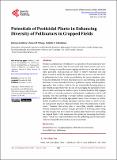| dc.contributor.author | Godifrey, Juliana | |
| dc.contributor.author | Mbega, Ernest | |
| dc.contributor.author | Ndakidemi, Patrick | |
| dc.date.accessioned | 2023-10-25T09:16:58Z | |
| dc.date.available | 2023-10-25T09:16:58Z | |
| dc.date.issued | 2018-12-21 | |
| dc.identifier.uri | http://www.scirp.org/journal/PaperInformation.aspx?PaperID=89316&#abstract | |
| dc.identifier.uri | https://dspace.nm-aist.ac.tz/handle/20.500.12479/2357 | |
| dc.description | A research article was submitted to American Journal of Plant Sciences Vol.09 ,2018 | en_US |
| dc.description.abstract | Declines in populations of pollinators in agricultural based landscapes have raised a concern, which could be associated with various factors such as intensive farming systems like monocropping and the use of non-selective synthetic pesticides. Such practices are likely to remove beneficial non-crop plants around or nearby the cropped fields. This may in turn result into losses of pollinators due to loss of the natural habitats for insects therefore, interfering the interaction between beneficial insects and flowering crop plants. Initiatives to restore friendly habitats for pollinators require multidisciplinary approaches. One of these could be the use of pesticidal flowering plants as part of field margin plants with the aim of encouraging the population of pollinators whilst reducing the number of pests. Farmers should be fully engaged in the efforts of creating conducive environments to pollinators and be well equipped with the knowledge of proper habitats management strategies in agricultural fields. Developing appropriate conservation strategies to combat decline of pollinators is of high importance and thus there is a need to evaluate management practices, which potentially favour the populations of pollinators. Therefore, this review aims at unravelling available evidences on habitats manipulation options through provision of flowering plants along the field margins that have shown to increase plant biodiversity surrounding the cropped fields. It also summarizes the options for increasing plant biodiversity, which have improved habitats for the pollinating insects and beneficially boosting pollination services in agro-ecosystems. | en_US |
| dc.language.iso | en | en_US |
| dc.publisher | Scientific Research Publishing | en_US |
| dc.subject | Beneficial Insects | en_US |
| dc.subject | Cropping Options | en_US |
| dc.subject | Plant-Insects Interaction | en_US |
| dc.subject | Pesticidal Plants | en_US |
| dc.subject | Pollinators | en_US |
| dc.title | Potentials of Pesticidal Plants in Enhancing Diversity of Pollinators in Cropped Fields | en_US |
| dc.type | Article | en_US |

